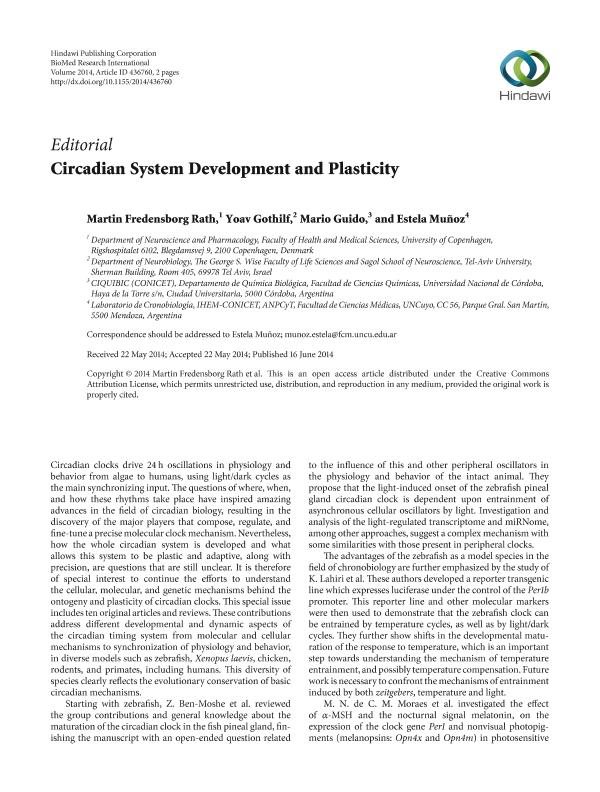Artículo
Circadian System Development and Plasticity
Fecha de publicación:
06/2014
Editorial:
Hindawi Publishing Corporation
Revista:
BioMed Research International
ISSN:
2314-6133
Idioma:
Inglés
Tipo de recurso:
Artículo publicado
Clasificación temática:
Resumen
Circadian clocks drive 24 h oscillations in physiology and behavior from algae to humans, using light/dark cycles as the main synchronizing input. The questions of where, when, and how these rhythms take place have inspired amazing advances in the field of circadian biology, resulting in the discovery of the major players that compose, regulate, and fine-tune a precise molecular clock mechanism. Nevertheless, how the whole circadian system is developed and what allows this system to be plastic and adaptive, along with precision, are questions that are still unclear. It is therefore of special interest to continue the efforts to understand the cellular, molecular, and genetic mechanisms behind the ontogeny and plasticity of circadian clocks. This special issue includes ten original articles and reviews. These contributions address different developmental and dynamic aspects of the circadian timing system from molecular and cellular mechanisms to synchronization of physiology and behavior, in diverse models such as zebrafish, Xenopus laevis, chicken, rodents, and primates, including humans. This diversity of species clearly reflects the evolutionary conservation of basic circadian mechanisms.
Palabras clave:
Circadian System
,
Development
,
Plasticity
,
Rhythmicity
Archivos asociados
Licencia
Identificadores
Colecciones
Articulos(CIQUIBIC)
Articulos de CENTRO DE INVEST.EN QCA.BIOL.DE CORDOBA (P)
Articulos de CENTRO DE INVEST.EN QCA.BIOL.DE CORDOBA (P)
Articulos(IHEM)
Articulos de INST. HISTOLOGIA Y EMBRIOLOGIA DE MEND DR.M.BURGOS
Articulos de INST. HISTOLOGIA Y EMBRIOLOGIA DE MEND DR.M.BURGOS
Citación
Muñoz, Estela Maris; Fredensborg Rath, Martin; Gothilf, Yoav; Guido, Mario Eduardo; Circadian System Development and Plasticity; Hindawi Publishing Corporation; BioMed Research International; 2014; 6-2014; 1-2; 436760
Compartir
Altmétricas




